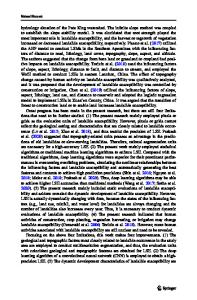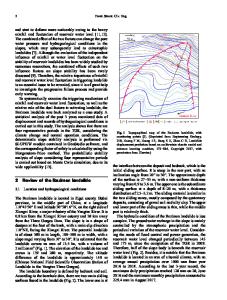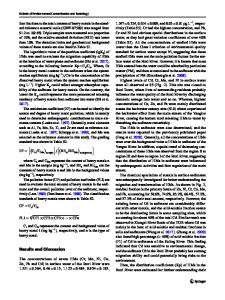The influence of water level fluctuation on the stability of landslide in the Three Gorges Reservoir
- PDF / 5,533,660 Bytes
- 10 Pages / 595.276 x 790.866 pts Page_size
- 6 Downloads / 387 Views
ORIGINAL PAPER
The influence of water level fluctuation on the stability of landslide in the Three Gorges Reservoir Yonggang Zhang 1,2,3 & Shuyun Zhu 2 & Junkun Tan 4 & Lindan Li 5 & Xiangjie Yin 6 Received: 30 December 2017 / Accepted: 12 August 2020 # Saudi Society for Geosciences 2020
Abstract In order to study the influence of water level fluctuation on the stability of landslide in the Three Gorges Reservoir (TGR), Xigouwan landslide was selected to be a research object to analyze its deformation mechanism as the fluctuation of the reservoir water level. Based on the long-term field monitoring of landslide, the evolution law of the surface has been studied. Based on the numerical simulation used by FLAC3D, five different water levels of TGR operating conditions are set, and the plastic zone, the factor of safety, change of displacement, and the seepage characteristics of the landslide were obtained to analyze the influence of water level fluctuation on the stability of landslide. Keywords Stability of landslide . Water level fluctuation . Field monitoring . Numerical simulation
Introduction China’s Three Gorges Dam project is one of the world’s largest hydroelectric projects. Since it commenced impounding in June 2003, there have been many catastrophic landslides to occur in TGR region. For example, the Qianjiangping landslide caused significant loss of life and property on July 14, 2003 (Wei et al. 2013; Wang et al. 2004, 2008; Jiang et al. 2012). As a result, the local government has conducted a series of landslide monitoring and found that some of the ancient landslides in this region have started to revive again and begun Responsible Editor: Zeynal Abiddin Erguler * Junkun Tan [email protected] 1
Key Laboratory of Geotechnical and Underground Engineering of Ministry of Education, and Department of Geotechnical Engineering, Tongji University, Shanghai 200092, China
2
School of Resources and Geosciences, China University of Mining and Technology, Xuzhou 221116, China
3
China Geological Survey, Beijing 100037, China
4
School of Civil Engineering, Central South University, Changsha 410083, China
5
Maanshan Institute of Mining Research, Maanshan 243000, China
6
School of Resources & Safety Engineering, Central South University, Changsha 410083, China
to produce significant deformation (Du et al. 2013; Miao et al. 2014; Hu et al. 2015; Wang et al. 2019a,b; Zhang et al. 2019a, b; Bao et al. 2019). Up until the dam’s completion in 2009, the highest water level in the reservoir is 175 m, with periodic fluctuation between 145 and 175 m. According to the geological disaster investigation of Land Resources Bureau, the total number of landslides triggered by the reservoir impoundment was more than 2000 (Jian et al. 2009;Gao and Meguid 2018; Wu et al. 2020; Yu et al. 2019; Zhou et al. 2020; Pu et al. 2020; Zhang et al. 2020c; Rong et al. 2020). Therefore, research into the deformation characteristics and mechanisms for achieving stability of landslides in the TGR region is imperative in the prediction,
Data Loading...











